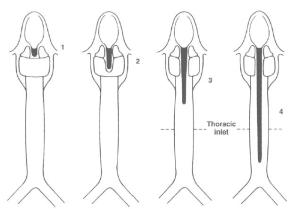Laryngeal Cleft
There are two tubes in your neck: The esophagus, which helps food and liquid pass from our mouth to the stomach and the trachea, which takes air to our lungs. Our voice box sits at the top of the trachea, in front of the esophagus and helps keep any food or liquid from getting into the tube leading to our lungs.
What is a Laryngeal Cleft ?

Benjamin and Inglis’ original classification. Leboulanger and Garabédian Orphanet Journal of Rare Diseases 2011 6:81
Children are born with a laryngeal cleft. We do not know what causes a laryngeal cleft to occur, but it happens during the early months of pregnancy. The cleft can vary from mild to severe; depending on how big the gap is between the esophagus and the airway.
There are 4 different types of Laryngeal Clefts and they worsen by type
- A type 1 laryngeal cleft is a gap that is located above the vocal cords. This is the mildest form.
- A type 2 laryngeal cleft extends below the vocal cords into the lower cartilage of the voice box.
- A type 3 laryngeal cleft extends beyond the voice box and into the trachea (windpipe).
- A type 4 laryngeal cleft extends even further down into the windpipe, and may go all the way to the bottom of the trachea. This is the most severe form.
Symptoms of a Laryngeal Cleft
- Coughing
- Choking with feedings
- Shortness of breath
- Poor weight gain
- Hoarseness
- Short pauses when breathing (apnea)
- Noisy breathing (stridor)
- Frequent lower respiratory infections (pneumonia)
- Food and / or liquid going into the lungs (aspiration)
- GERD (GastroEsophagealReflux)
Diagnosis of a Laryngeal Cleft
A laryngeal cleft is definitively diagnosed with an airway evaluation in the OR. Sometimes prior to this the child may need other X-rays or tests to evaluate swallowing or other abnormalities.
- Some children, who have few symptoms and small clefts, do not need surgery. These children are checked often for any changes in their symptoms.
- If a child continues with aspiration or breathing concerns, the doctor will discuss what care options or surgeries are best for the child. Surgery for this condition is called a laryngeal cleft repair.
(Adapted from Cincinnati Children’s Health Topics)

